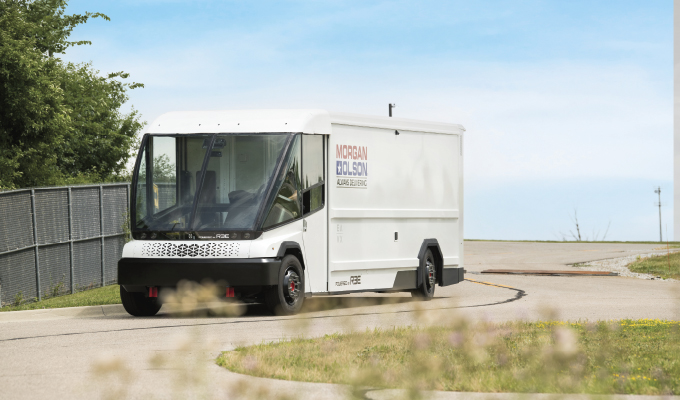Did you see REE Automotive’s REEcorner technology at the 2022 Work Truck Show? I wrote a bit about the revolutionary technology in a Work Truck Show review in our March issue. I wrote: “REE essentially redesigned vehicles as we know them with its REEcorners that integrate all critical vehicle components into the arch of the wheel.”
I was impressed with the technology, albeit confused because the company had quite literally reinvented the wheel. Yet, no matter how impressed I was, I expected it to be a few more years before the company developed something for the North American market. Boy, was I wrong.
But, REE didn’t develop a vehicle for the North American market on its own. The company partnered with Morgan Olson, who collaborated with EAVX, to develop the body of the vehicle. Morgan Olson needs no introduction, but remember EAVX? A division of JB Poindexter and Co. (JBPCO), EAVX works with JBPCO’s brands and other industry players to improve electric chassis and truck body integration. Mark Hope, EAVX COO and general manager, explained it best in our March issue: “Traditionally, there were two different streams of operations: those that work exclusively with the truck body, and those that work exclusively with the chassis. EAVX’s goal is to bridge the gap between the two and collaborate with different chassis manufacturers to enhance the electric value to the customer.”
Having three different players, especially these three, collaborate on a new vehicle is enough to gain some interest, and I had the opportunity to get up close and personal with the product of the collaboration—the Proxima walk-in van.
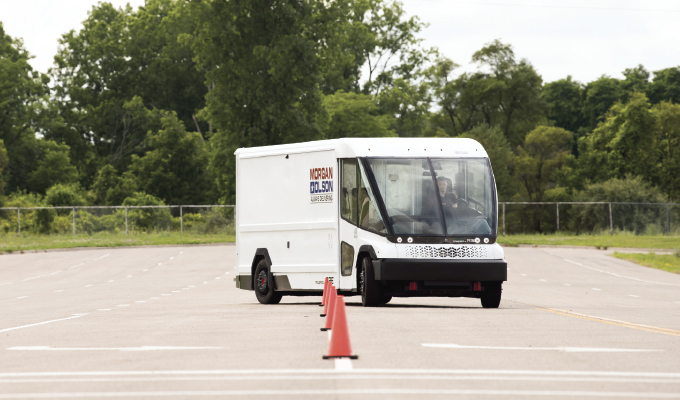
THE PLATFORM
If you’re not at all familiar with REE Automotive, the Israel-based company’s REEcorner technology allows for a completely flat electric chassis that gives owners up to 35% more interior cargo volume, according to REE. This is because all critical vehicle components are resting between the chassis and the wheel (didn’t I say the company reinvented the wheel?). This works through x-by-wire technology, meaning that once a driver turns the steering wheel or presses the brake pedal, instead of an actual mechanical operation, the vehicle operates electronically—or by wire. This electronic operation has the potential to completely transform the way vehicle bodies are made.
Omitting mechanical components also frees up space for more cargo. According to REE’s website, walk-in vans built on the company’s P7 EV chassis (Class 3-5) also offer the industry’s lowest step-in height—in fact, a REE chassis allows a floor height as low as 20 inches. Another perk of x-by-wire operation is that having independent motors in each wheel allows for all-wheel, bidirectional steering, which vastly improves maneuverability.
Finally, REE states that the P7 chassis’ maintenance isn’t so bad, either. Because REEcorners are identical and each features all necessary drive components, if an issue arises out of one, it can simply be replaced. REE Automotive also offers over-the-air software updates and preventive maintenance artificial intelligence, much like many OEMs offer today. Pair all of that with a brand new walk-in van body, and you’ve got a recipe for innovation.
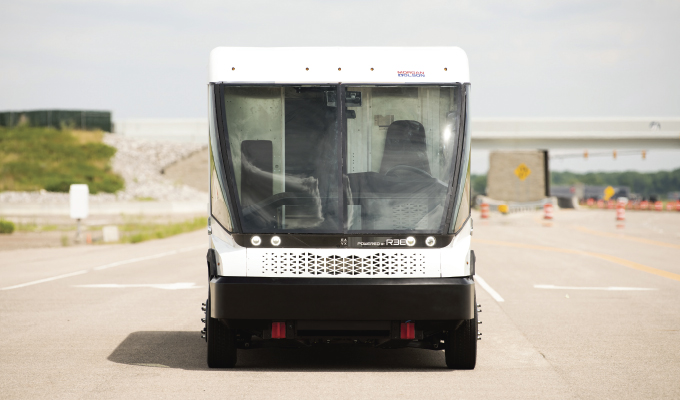
THE BODY
The body aspect of that innovation was born through another collaboration. Morgan Olson and EAVX designed the Proxima body specifically for use on an electric platform. This intention brought about some significant changes to the conventional cab we’re used to seeing and driving on the road today. Designed to be optimally aerodynamic with a low, flat platform, the Proxima delivers a drag reduction of 56%. That low platform also allows for a load floor height that is one step lower than other vans. Delivery drivers will appreciate fewer steps getting in and out of the van, and the omission of one step can even speed up deliveries.
Speaking of delivery drivers, the design team at Morgan Olson had a goal to improve driver visibility in the Proxima. As a result, the van’s windshield, dash, and side- and rear-view screens give drivers an enhanced view of the road ahead and beside them—this is about a 25% blind spot improvement from other walk-in van models. Additionally, with a lower driver seating position due to the flat P7 chassis, drivers’ visibility is further improved.
The Proxima also gets EAVX’s VX Control, a digital vehicle infrastructure that allows an array of connected technologies. These technologies communicate with each other and with drivers regardless of the chassis or powertrain used in the vehicle. VX Control in the Proxima unifies equipment, cameras, tools, lighting, sensors, and driver assistance technologies into a single system. As a result, this unified technology system delivers lower operational costs and higher efficiency.
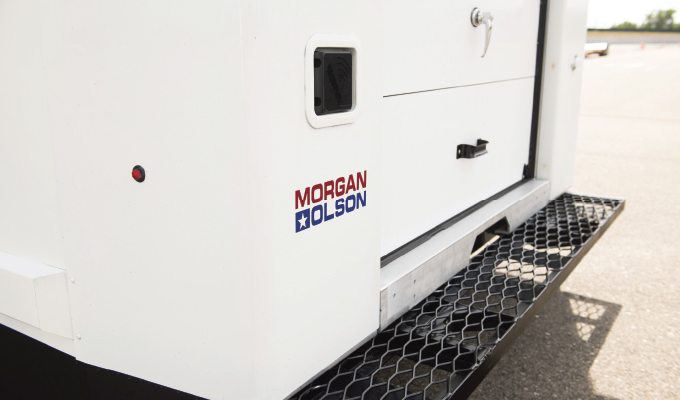
POWER OF THREE
This three-way integration with REE Automotive, Morgan Olson, and EAVX is a lot to take in. The collaboration brought us a brand new walk-in van with a completely flat platform with motors in each wheel as well as a totally redesigned, EV-optimized cab. But enough with the flash; now for the specs.
The Class 5 Proxima walk-in van has 100 kW peak motor power in each wheel, 136 Nm peak torque in each wheel, and its maximum speed is 75 mph. The all-wheel-drive, all-wheel-steer Proxima can travel roughly 125 miles on one charge. It has a GVWR of 19,500 lbs, an 8,000-lb payload, and a cargo volume of 1,000 cu ft.
I was impressed with the visibility of the Proxima during my ride-along, and I just had to hold my phone out of the cab to capture a video of the bidirectional wheel movements—otherwise I might not have believed it. The three companies conducted the ride-along experience on a closed test track, but all invited were able to experience its sharp turning radius and how easily it weaved through a lineup of traffic cones.
But not only did we get to ride in the Proxima, a conventional Morgan Olson walk-in van was on the premises so that we could compare the two. Clearly there were drastic differences in height (both floor height and overall height) as well as floor and cargo space—not to mention the futuristic look and increased visibility of the Proxima.
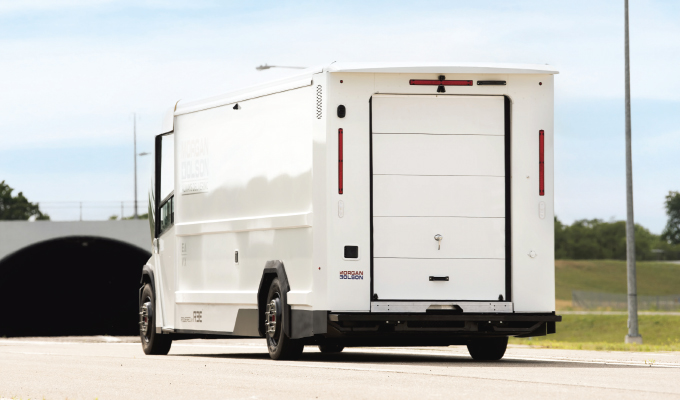
ONLY THE BEGINNING
Perhaps one of the coolest things about the Proxima body and the REE platform is that both components are agnostic. As mentioned, the REEcorner platform can be used with a variety of available bodies or custom bodies according to the owners’ application, specifications, and preferences. In the same way, the Proxima body can be used with either electric powertrains or conventional powertrains on different platforms. This is simply the first pairing for both the REE Automotive platform and the Proxima body in North America, but, it surely won’t be the last pairing for either of these groundbreaking concepts.
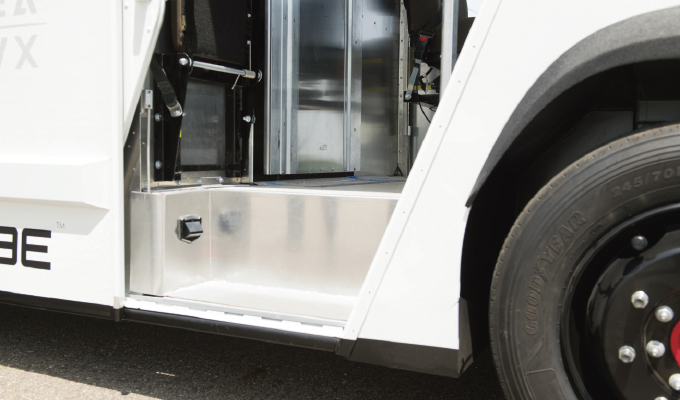
ABOUT THE AUTHOR
Jade Brasher is the editor of Modern WorkTruck Solutions magazine. Reach her at jade@mwsmag.com. Find out more about the EAVX Proxima van, visit www.lastmileevolution.com.


